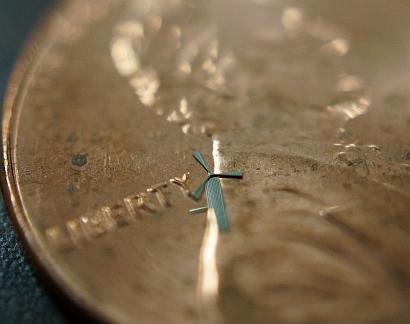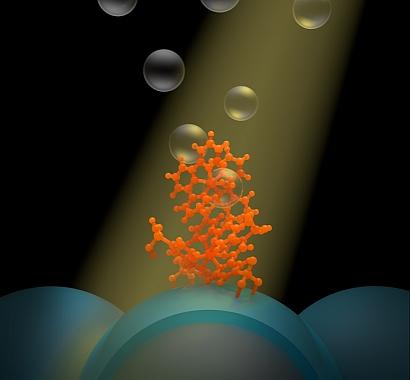
Power Week-in-Review: Micro Windmill, Storing 'Solar Fuel' & Next-Gen WPC Controller
Researchers at the University of Texas Arlington have designed a MEMS-based "micro-windmill" that they hope may offer a solution for recharging batteries in mobile devices (see image and video below). With blades measuring 1.8 mm in diameter, and constructed of a nickel alloy, the device is small and robust enough that hundreds could be embedded in the surface of a case of a cellphone, which when waved in the air or exposed to wind would generate energy that could be stored in the phone's battery. Other applications are also being explored.

Researchers at the Energy Frontier Research Center at the University of North Carolina have developed a system that converts solar energy directly into hydrogen fuel and then stores it for later use. The photosynthesis-like system uses solar energy to split water into its constituent parts -- hydrogen and oxygen -- and then specially coated nanoparticles to keep them separated while enabling the successful storage of the hydrogen while the oxygen is released as a byproduct (see image below). The researchers hope this approach could make solar energy more practical by offering a more energy dense way of storing it.

In product news, Texas Instruments has introduced its next-generation wireless power transmitter manager with foreign object detection. The bq500412 controller integrates all functions needed to control wireless power delivery to a single WPC1.1-compliant receiver and can be combined with a boost converter to create a 3-coil, 5-V USB charging pad.
CUI has announced new 3-W isolated dc-dc converter families for industrial, test and measurement, and telecommunication applications. The PQMC3-S Series and PQM3-M Series are housed in compact 8-pin SIPs and 16-pin SMT packages, respectively.
A dual-phase synchronous step-down slave controller from Linear Technology generates up to 300 A when paired with a companion master controller by extending the phase count in multiphase applications. The LTC3874 operates from an input range of 4.5 to 38 V and produces a fixed output of up to 5.5 V.
International Rectifier has announced isolated hybrid hermetic dc/dc converters for high-temperature and high-shock environments. The 55-W HTH27022S and 92-W HTM27092S feature an operating case temperature of 165°C (up to 175°C transient) and a nominal input voltage of 270 V.
A 35-W dc/dc converter module from Murata is designed for FPGA and embedded applications. The 12-V-input OKLP-X/35-W12-C measures 25.4 x 12.7 x 11.1 mm and has a 94% efficiency.
Exar Corp. has introduced a synchronous step-down controller featuring the company's current-mode Constant On-Time (COT) control loop. The XRP6141 supports PoL supplies up to 35 A and has a 4.5 to 22-V input range and an adjustable 0.6 to 18-V output range.
A 30-V asymmetric dual N-channel TrenchFET power MOSFET from Vishay Intertechnology is claimed to offer a 57% lower RDS(on) than previous-generation devices in the same package size. Housed in a 3 x 3-mm package, the SiZ340DT is optimized for synchronous buck designs in cloud computing applications, and various client-side electronic devices and mobile computing applications.
Finally, new high-current shunt resistors from Stackpole use a raised metal element to improve current and surge handling while minimizing heat to surrounding components. The HCS Series is available in 3-W 2512 and 5-W 3920 chip sizes, in values of 0.3, 0.5, and 1 mΩ.









